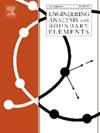Sphere elements in the BEM for the analysis of elastic bodies with spherical voids or inclusions
IF 4.2
2区 工程技术
Q1 ENGINEERING, MULTIDISCIPLINARY
Engineering Analysis with Boundary Elements
Pub Date : 2025-02-01
DOI:10.1016/j.enganabound.2024.106057
引用次数: 0
Abstract
In this paper, a series of novel sphere elements are proposed in the boundary element method (BEM). These elements are designed as isoparametric closure elements to simulate spherical geometries with greater accuracy and fewer nodes than conventional boundary elements. Constructed similarly to multi-dimensional Lagrange elements, these sphere elements utilize trigonometric bases for each dimension. To avoid zero Jacobians at polar nodes, poleless sphere elements combined with triangular elements are employed to approximate spheres. The evaluation methods of boundary integrals over these elements, including singular and nearly singular integrals, are derived using degenerated element techniques and adaptive subdivision techniques, respectively. Three numerical examples are employed to underscore the advantages of the proposed elements, showing that with only 50 nodes per sphere, results align closely with those obtained using 290 nodes per sphere with conventional boundary elements, effectively reducing degrees of freedom without sacrificing accuracy.
边界元法中用于分析具有球形空隙或夹杂的弹性体的球面元
在边界元法(BEM)中,提出了一系列新的球面元。这些元素被设计为等参闭合元素,以更高的精度和更少的节点模拟球面几何比传统的边界元素。构造类似于多维拉格朗日元素,这些球体元素利用三角基底为每个维度。为避免在极节点处雅可比矩阵为零,采用无极球面单元与三角形单元相结合的方法逼近球面。分别利用退化单元法和自适应细分法推导了这些元素的边界积分的求值方法,包括奇异积分和近奇异积分。三个数值算例表明,在每个球体只有50个节点的情况下,得到的结果与使用传统边界单元每个球体290个节点得到的结果非常接近,在不牺牲精度的情况下有效地降低了自由度。
本文章由计算机程序翻译,如有差异,请以英文原文为准。
求助全文
约1分钟内获得全文
求助全文
来源期刊

Engineering Analysis with Boundary Elements
工程技术-工程:综合
CiteScore
5.50
自引率
18.20%
发文量
368
审稿时长
56 days
期刊介绍:
This journal is specifically dedicated to the dissemination of the latest developments of new engineering analysis techniques using boundary elements and other mesh reduction methods.
Boundary element (BEM) and mesh reduction methods (MRM) are very active areas of research with the techniques being applied to solve increasingly complex problems. The journal stresses the importance of these applications as well as their computational aspects, reliability and robustness.
The main criteria for publication will be the originality of the work being reported, its potential usefulness and applications of the methods to new fields.
In addition to regular issues, the journal publishes a series of special issues dealing with specific areas of current research.
The journal has, for many years, provided a channel of communication between academics and industrial researchers working in mesh reduction methods
Fields Covered:
• Boundary Element Methods (BEM)
• Mesh Reduction Methods (MRM)
• Meshless Methods
• Integral Equations
• Applications of BEM/MRM in Engineering
• Numerical Methods related to BEM/MRM
• Computational Techniques
• Combination of Different Methods
• Advanced Formulations.
 求助内容:
求助内容: 应助结果提醒方式:
应助结果提醒方式:


